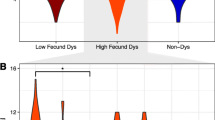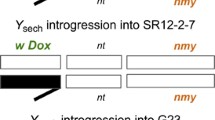Summary
The term “hybrid dysgenesis” describes a syndrome of genetic effects which sometimes results when Drosophila melanogaster from wild populations are outcrossed; this syndrome often includes male recombination as well as enhanced rates of genic and chromosomal mutation, sterility, and transmission ratio distortion. In this study, we have examined the mechanism of T-007-induced male recombination by genetically characterizing third chromosomes generated by an exchange in a well-marked euchromatic region. Most recombinant chromosomes were sequentially normal, and no recessive lethal events at the point of exchange were recovered. The results demonstrate that although some recombinants may be generated by nonhomologous chromosome (or chromatid) breakage and reunion, the predominant effect of T-007 is through an enhanced rate of normal mitotic exchange. The rate of mitotic exchange is also increased by ionizing radiation and chemical mutagens; we suggest that the common factor in all three cases is the induction of single strand breaks.
Similar content being viewed by others
References
Becker HJ (1976) Mitotic recombination. In: Ashburner M, Novitski E (eds) Genetics and Biology of Drosophila, vol 1c. Academic Press, London, p 1019
Berg R, Engels WR, Kreber RA (1980) Site-specific X-chromosome rearrangements from hybrid dysgenesis in Drosophila melanogaster. Science 210:427–429
Bouchard RA, Stern H (1980) DNA synthesized at pachytene in Lilium: A nondivergent subclass of moderately repetitive sequences. Chromosoma (Berl) 81:349–364
Bregliano JC, Picard G, Buchaton A, Pelisson A, Lavige JM, L'Heritier P (1980) Hybrid dysgenesis in Drosophila melanogaster. Science 207:606–611
Brodberg RK, Woodruff RC (1981) Chromosome breakage in natural population lines of Drosophila melanogaster. Genetics 97:s16 (abstract)
Calos MP, Miller JH (1980) Transposable elements. Cell 20:579–595
Catcheside DG (1977) The Genetics of Recombination. University Park Press, London
Dunsmuir P, Brorein WJ Jr, Limon MA, Rubin GM (1980) Insertion of the Drosophila transposable element copia generates a 5 base pair duplication. Cell 21:575–579
Engels WR (1979) Extrachromosomal control of mutability in Drosophila melanogaster. Proc Natl Acad Sci USA 76:4011–4015
Farabaugh PJ, Fink GR (1980) Insertion of the eukaryotic transposable element Ty 1 creates a 5-base pair repeat. Nature 286:352–356
Fincham JRS, Sastry GRK (1974) Controlling elements in maize. Annu Rev Genet 8:15–50
Green MM (1976) Mutable and mutator loci. In: Ashburner M, Novitski E (eds) Genetics and Biology of Drosophila, vol 1b. Academic Press, London, p 929
Green MM (1977) Genetic instability in Drosophila melanogaster: De novo induction of putative insertion mutations. Proc Natl Acad Sci USA 74:3490–3493
Green MM (1978) The genetic control of mutation in Drosophila. Stadler Genet Symp 10:95–104
Green MM (1980) Transposable elements in Drosophila and other Diptera. Annu Rev Genet 14:109–120
Harshey RM, Buckhari AI (1981) A mechanism of DNA transposition. Proc Natl Acad Sci USA 78:1090–1094
Henderson SA, Woodruff RC, Thompson JN Jr (1978) Spontaneous chromosome breakage at male meiosis associated with male recombination in Drosophila melanogaster. Genetics 88:93–107
Hiraizumi Y (1971) Spontaneous recombination in Drosophila melanogaster males. Proc Natl Acad Sci USA 68:268–270
Hiraizumi Y (1977) The relationships among transmission frequency, male recombination and progeny production in Drosophila melanogaster. Genetics 87:83–93
Hiraizumi Y (1979a) A new method to distinguish between meiotic and premeiotic recombinational events in Drosophila melanogaster. Genetics 92:543–554
Hiraizumi Y (1979b) A model of the negative correlation between male recombination and transmission frequency in Drosophila melanogaster. Genetics 93:449–459
Hiraizumi Y, Slatko B, Langley C, Nill A (1973) Recombination in Drosophila melanogaster male. Genetics 73:439–444
Holden JJ, Suzuki DT (1973) Temperature-sensitive mutations in Drosophila melanogaster XII. The genetic and developmental effects of dominant lethals on chromosome 3. Genetics 73:445–458
Hotta Y, Chandley AC, Stern H (1977) Meiotic crossing-over in lily and mouse. Nature 269:240–242
Kidwell MG, Kidwell JF, Sved JA (1977) Hybrid dysgenesis in Drosophila melanogaster: a syndrome of aberrant traits including mutation, sterility and male recombination. Genetics 86:813–833
Lindsley DL, Grell EH (1968) Genetic Variations of Drosophila melanogaster. Carnegie Institute of Washington publication 627
Lindsley DL, Sandler L, Baker BS, Carpenter ATC, Denell RE, Hall JC, Jacobs PA, Miklos GLG, Davis BK, Gethmann R, Hardy RW, Hessler A, Miller SM, Nozawa H, Parry DM, Gould-Somero M (1972) Segmental aneuploidy and the genetic gross structure of the Drosophila genome. Genetics 71:157–184
Nevers P, Saedler H (1977) Transposable genetic elements as agents of gene instability and chromosomal rearrangements. Nature 268:109–115
Pasztor LM (1976) Aneuploidy in Drosophila melanogaster. In: Ashburner M, Novitski E (eds) Genetics and Biology of Drosophila, vol 1a. Academic Press, London, p 185
Ratnayake WE (1970) Studies on the relationship between induced crossing-over and mutation in Drosophila melanogaster. Mutat Res 9:71–83
Simmons MJ, Lim JK (1980) Site-specificity of mutations arising in dysgenic hybrids of Drosophila melanogaster. Proc Natl Acad Sci USA 77:6042–6046
Sinclair DAR, Green MM (1979) Genetic instability in Drosophila melanogaster: The effect of male recombination (MR) chromosomes in females. Mol Gen Genet 170:219–227
Slatko B (1978) Parameters of male and female recombination influenced by the T-007 second chromosome in Drosophila melanogaster. Genetics 90:257–276
Slatko B, Hiraizumi Y (1975) Elements causing male crossing over in Drosophila melanogaster. Genetics 81:313–324
Slatko B, Green MM (1980) Genetic instability in Drosophila melanogaster. Mapping the mutator activity of an MR strain. Biol Zentralbl 99:149–155
Stern H (1981) Chromosome organization and DNA metabolism in meiotic cells. In: Bennett MD, Bobrow M, Hewitt C (eds) Chromosomes Today, vol 7. George, Allen & Unwin, London, p 94
Sved JA (1978) Male recombination in dysgenic hybrids of Drosophila melanogaster: chromosome breakage or mitotic crossing-over? Aust J Biol Sci 31:303–309
Sved JA (1979) The “hybrid dysgenesis” syndrome in Drosophila melanogaster. Bioscience 29:659–664
Thompson JN Jr, Woodruff RC (1978a) Mutator genes — pacemakers of evolution. Nature 274:317–321
Thompson JN Jr, Woodruff RC (1978b) Chromosome breakage: A possible mechanism for diverse genetic events in outbred populations. Heredity 40:153–157
Voelker RA (1974) The genetics and cytology of a mutator factor in Drosophila melanogaster. Mutat Res 22:265–276
Yannopoulos G (1978) Studies on male recombination in a Southern Greek Drosophila melanogaster population (c) Chromosomal abnormalities at male meiosis (d) Cytoplasmic factor responsible for the reciprocal cross effect. Genet Res Camb 31:187–196
Yannopoulos G, Zacharopoulou A (1980) Studies on the chromosomal rearrangements induced by the male recombination factor 31.1 MRF in Drosophila melanogaster. Mutat Res 73:81–92
Author information
Authors and Affiliations
Additional information
Communicated by Ch. Auerbach
Rights and permissions
About this article
Cite this article
Isackson, D.R., Johnson, T.K. & Denell, R.E. Hybrid dysgenesis in Drosophila: The mechanism of T-007-induced male recombination. Mol Gen Genet 184, 539–543 (1981). https://doi.org/10.1007/BF00352536
Received:
Issue Date:
DOI: https://doi.org/10.1007/BF00352536




